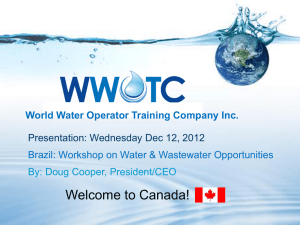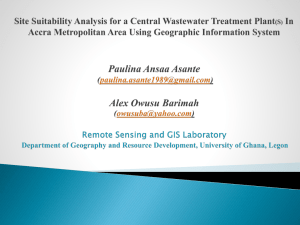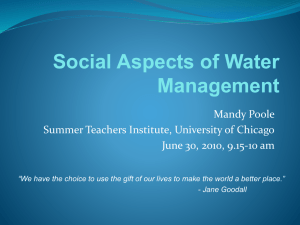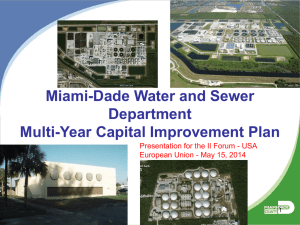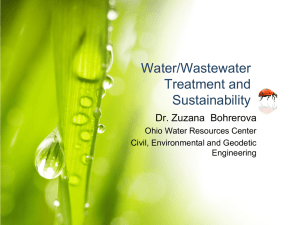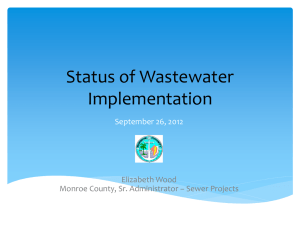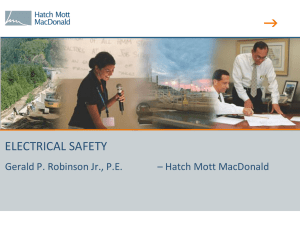`Achieving Sustainability - India`s Needed Water
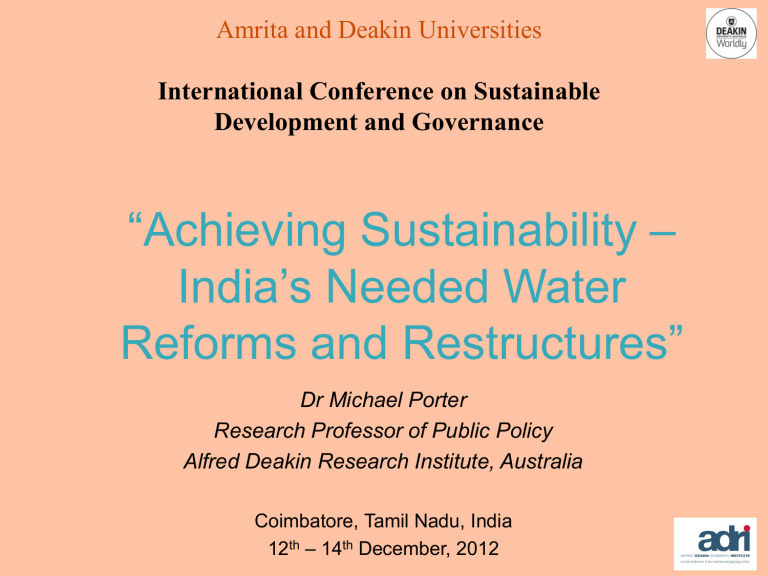
Amrita and Deakin Universities
International Conference on Sustainable
Development and Governance
“Achieving Sustainability –
India’s Needed Water
Reforms and Restructures”
Dr Michael Porter
Research Professor of Public Policy
Alfred Deakin Research Institute, Australia
Coimbatore, Tamil Nadu, India
12 th – 14 th December, 2012
The Water Crisis can Spoil an Indian Century
The National Commission on Water and the World Bank have agreed: water balances in India are precarious, unsustainable.
By 2050 demands will exceed all available sources of supply; pockets of catastrophe.
Unless desalination becomes economic and affordable thanks to general economic development. Energy costs say this can be only a part of the story in selected areas.
Over 15 percent of all aquifers are in critical condition, a number which will grow to
60 percent in the next 25 years unless there is change.
About 15 percent of India’s food is being produced using non-renewable, ‘mined’, groundwater.
The social and economic consequences of continued ‘muddling through’ are huge.
It’s not just physical capital; It’s the structure of rules, laws and incentives
So …..The challenge in water in India is …
Turning Dead Water Capital into Live Capital
World Bank-GOI Assessment: 2005
“ India faces a turbulent water future. The current water development and management system is not sustainable: unless dramatic changes are made—and made soon—in the way in which government manages water, India will have neither the cash to maintain and build new infrastructure, nor the water required for the economy and for people.”
INDIA’S WATER ECONOMY - BRACING FOR A TURBULENT FUTURE
Prof John Briscoe , Harvard, (then Head of Water, World Bank) and Dr R.P.S. Malik , University of Delhi (Editors
), drawing on papers by:
The evolution of national policies and programs ( Mr. A.D. Mohile, former Chair, Central Water Commission )
• The evolution of water development and management, (
Mr. A Sekhar, Adviser, Planning Commission )
• The evolution and performance of World Bank work on water in India (
Dr. R.P.S. Malik, University of Delhi )
• Water and growth ( Professor Ramesh Bhatia, Institute of Economic Growth, University of Delhi ),
• Water and poverty ( Dr. R.P.S. Malik, University of Delhi )
• Water and environmental sustainability ( Mr. George Varughese, Development Alternatives )
• Water and energy ( Professor Ramesh Bhatia, Institute of Economic Growth, University of Delhi )
• Pricing and financing ( Professor Sebastian Morris, Indian Institute of Management Ahmedabad )
• Water rights and entitlements ( Dr. Maria Saleth, International Water Management Institute, Colombo )
• Accountable institutions ( Dr. Tushaar Shah, International Institute of Water Management, Anand )
• Moving to scale ( Dr. Nirmal Mohanty, Infrastructure Finance Development Corporation )
• The political economy of change (
Professor V.S. Vyas, Institute of Development Studies, Jaipur )
So: What Does a 2012 Stocktake Reveal?
The Constraints of Nature
India has a highly seasonal rainfall,
50 percent of precipitation in just 15 days
90 percent of river flows in just 4 months
The storage, treatment and asset maintenance needs…are huge
But while water is affected by nature, the absence of structures for managing scarcity kills reform
In organizational structures, incentives, trading so that water gets to the most highly valued uses
Create a critical need for market tools, institutions, incentives and accountability
Defined entitlements and rights to sell, vesting current rights
Pollution, discharges and losses need to be charged for
Trading both water and entitlements, where Australia has leading expertise
Need to invest in new allocation structures, trading and technologies
Expertise, training and education support for a dynamic growth industry
To treat water with the respect a really scarce and vital essential service deserves
Population data
Urban population
Rural population
Total population
Population (million) Growth rate
2008 2016 2005 10 2010-15
349.5
426.0
(29.5%) (32.3%)
835.1
893.8
(70.5%) (67.7%)
2.4%
1.1%
2.5%
0.8%
1,184.6 1,319.8 1.5% 1.3%
India:
Key Water
Investment and
Coverage
Data
GDP data
GOP in 2008 Nominal GOP GOP at PPP
Total GOP $1,206.7 billion $3,297.8 billion
GOP per capita $1,019 $2,784
Water resources and scarcity data
Total renewable water resources : 1,880 .
0 km 3 /y r
Total annual water withdrawal : 645.9 km 3 /yr
Per capita renewable reources 2008: 1,587 m 3 jy r
Per capita renewable reources 2016: 1,425 m 3 /yr
Population facing scarcity 2008: 466,204,000
Global Water
Intelligence
2012
Water utility data
Total utility water supply : 26,500 .
00 million m 3 jyr
Water service coverage: 80.0
%
Water population served: 939 .
0 million
Water network length: 508 , 000-580,500
Metering penetration: n;a
Non-revenue water: 18.0
%
Average water tariff: $0.08jm
3
Wastewater utility data
Total wastewater capacity: 2,966.40 million m 3 jyr
Wastewater service coverage : 15 .
0 %
Wastewater population served: 176.6 million
Wastewater network length: 161 300 km
Collected wastewater receiving secondary treatment or better: 24 .
0 %
Average wastewater tariff: $0.01jm 3
Sectoral GDP and water withdrawal
Industry 5.5%
Manufacturin g
16 .
3%
Agriculture 86 .
5 %
Market drivers
Scarcity
Demographics
Priority for wastewater
Total utility water market, 2010
Finance
Municipal water capex $1,568.1m
Municipal wastewater opex $174.9m
Anticipated CAGR 2010-2016: +8.8%
During this period the total market value will increase from
$3,901.2 millionjyr to $6,460.6 million/yr.
Population data
Population (million) Growth rate
Urban population
Rural population
Total population
2008 2016 2005-10 2010-15
574.8
699.7
(43.1%) (50.1%)
759.1
697.5
(56.9%) (49.9%)
1,333.9 1,397.2
2.7%
-1.0%
0.6%
2.4%
-1.1%
0.5%
China:
Key Water
Investment and
Coverage
Data
GDP data
GOP in 2008 Nominal GOP GOP at PPP
Total GOP $4,327.4 billion $7,926.5 billion
GOP per capita $3,244 $5,942
Water resources and scarcity data
Total renewable water resources: 2,830.0 km 3 jyr
Total annual water withdrawal: 630.4 km 3 /yr
Per capita renewable reources 2008: 2,122 m 3 jyr
Per capita renewable reources 2016: 2,026 m 3 /yr
Population facing scarcity 2008: 391,025,000
Water utility data
Total utility water supply: 97,090.00 million m 3 /yr
Water service coverage : 94.7%
Water population served: 355.0 million
Water network length: 480,084 km
Metering penetration: n/a
Non-revenue water: 36.0%
Average water tariff: $0.27 jm 3
Global Water
Intelligence
2012 Wastewater utility data
Total wastewater capacity: 15,915.42 million m 3 /yr
Wastewater service coverage: n/a
Wastewater population served: n;a
Wastewater network length: 315,200 km
Collected wastewater receiving secondary treatment or better: 62.2%
Average wastewater tariff: $0.12/m 3
Sectoral GDP and water withdrawal
Industry 25.7%
Agriculture 12.5%
Manufacturing
33.5%
Agriculture 67.7%
Market drivers
Industry 47.5%
Scarcity infrastructure
Demographics
Priority for wastewater
Total utility water market, 2010
Municipal water apex $7,783.0m
Municipal wastewater capex $14,066.7m
Municipal wastewater opex
$3,130.8m
Municipal water capex $17,087.5m
Anticipated CAGR 2010-2016: +8.6%
During this period the total market value will increase from
$42,068.0 million/yr to $69,047.9 million/yr.
Global Water Intelligence
Australia
Country snapshot
Population data
Population (million) Growth rate
2008 2016 2005-10 2010-15
Urban population
Rural population
Total population
18.6
(88.7%)
2.4
(11.3%)
20.9
20.4
(90.1%)
2.2
(9.9%)
22.6
1.2%
-0.6%
1.0%
1.1%
-0.6%
1.0%
GDP data
GDP in 2008
Total GDP
Nominal GDP
GDP per capita $48,420
GDP at PPP
$1,013.5 billion $799.1 billion
$38,176
Australia
:
Key Water
Investment and
Coverage
Data
Water resources and scarcity data
Total renewable water resources: 492.0 km³/yr
Total annual water withdrawal: 23.9 km³/yr
Per capita renewable reources 2008: 23,506 m³/yr
Per capita renewable reources 2016: 21,759 m³/yr
Population facing scarcity 2008: 7,259,000
Water utility data
Total utility water supply: 2,034.00 million m³/yr
Water service coverage: 97.0%
Water population served: 20.8 million
Water network length: 136,845 km
Metering penetration: 95.0%
Non-revenue water: 18.0%
Average water tariff: $1.80/m³
Global Water
Intelligence
2012
Wastewater utility data
Total wastewater capacity: 1,982.00 million m³/yr
Wastewater service coverage: 94.0%
Wastewater population served: 19.3 million
Wastewater network length: 117,606 km
Collected wastewater receiving secondary treatment or better: 100.0%
Average wastewater tariff: $1.73/m³
23.9 km³/yr
$1,013.5 billion
23.9 km³/yr
$1,013.5 billion
Sectoral GDP and water withdrawal
Industry 10.0%
Domestic
14.7%
Total water withdrawal
Services
69.0%
Agriculture 3.1%
Nominal GDP
$1,013.5 billion
Manufacturing
11.0%
Industry
23.9 km³/yr 28.0%
Scarcity
Agriculture
Deterioration of infrastructure
75.3%
Market drivers
Deterioration of infrastructure
Demographics
Scarcity
5
4
3
2
1
Governance
Governance
Finance
Demographics
Priority for wastewater
Priority for wastewater
Finance
Total utility water market, 2010
Municipal wastewater capex $1,760.9m
Municipal water opex $4,199.5m
Municipal water capex $3,518.3m
$13,202.8m
Total market value
(2010)
Municipal wastewater opex $3,724.1m
Anticipated CAGR 2010-2016: +1.6%
During this period the total market value will increase from
$13,202.8 million/yr to $14,528.8 million/yr.
Global Water Market 2011 www.globalwaterintel.com
India Water Expenditures
Utility water expenditure
2,500 -----------------
Utility wastewater expenditure
500 -------------------
=
..
----_-_-_-_-_-_-_-_-_-_-_ -c
E
2,000
1,500
-----
c
E
400 -
300
-------------------, -""!
:......
1,000
---------------
2010
•
Water resources
2012 2014 2016 o ------------------
2010 2012 2014 2016
•
Network rehabilitation capex
•
Operating expenditure
• Network expansion capex •
Treatment plants capex • Other wastewater
Water market data ($ million)
Municipal water
Water resources
Network expansion capex
Network rehabiliation capex
Treatment plants capex
Total water capex
Municipal water opex
Municipal wastewater
Network expansion capex
Network rehabilitation capex
Treatment plants capex
Other wastewater
Total wastewater capex
Municipal wastewater opex
Total municipal market
2010
1,040.5
226.1
188.4
113.0
1,568.1
1,574 .
5
2011
625.4
475.6
396.4
237.8
1,735.2
1,629.6
2012
657.9
529.1
440.9
264 .
5
1,892.4
1,686.6
2013
842.5
528.3
440.3
264 .
2
2,075.3
1,785.3
2010
122.6
335.4
92.9
32.8
583.7
174.9
2011
141.4
371.3
107.9
40.3
660.8
181.1
2012
166.7
404.8
133.0
45.1
749.5
187.4
2013
198.0
359.5
210.3
49.2
817.0
216.2
3,901.2 4,206.7 4,516.0 4,893.8
2014
992 .
6
591 .
6
493 .
0
295 .
8
2,373 .
0
1,894 .
9
2014
233 .
7
356 .
2
247 .
1
53.6
890.5
248.7
2015
1,028.3
691.7
576.4
345 .
8
2,642 .
1
2,011.1
2015
274.1
349.4
288.7
58.4
970.7
284.7
2016
1,181.6
755.2
629 .
3
377.6
2,943.7
2,134.2
2016
309.3
361.9
314.7
72.2
1,058.0
324.6
5,407.1 5,908.6 6,460.6
Water Assets – Much Dead Capital?
An Unsustainable Situation that is getting worse with economic development
Many Indian water assets are what de Soto * calls “dead capital”
Incentives to maintain dams, pipes, connections are not generally vested in “owners”. So assets degrade. Customers denied.
Need for legal ownership of all assets in groups, communities or companies. Without secure water, other investments at risk.
Need scope to buy and sell those water and infrastructure entitlements and have incentives to maintain and enhance.
Make water investible.
If assets well vested and exchangeable, then they can secure other investment loans – becoming live capital!
* Hernando de Soto: The Mystery of Capital: Why Capitalism Works in the West and Fails Everywhere Else, 2000
A personal story, from Madurai, 1960s
• In the 1960s I travelled in Tamil Nadu and India as part of an Australian student group – at this point with a clinic
• I took a not unusual photo at a lake where water sharing was going on out of Madurai, featuring:
• Washing, clothes and personal
• Discharge of waste water
• Animals drinking
• Collection of drinking water
• Life expectancy was around 27
• One solution is simple rights for water purposes, fees and bans on particular uses. Easier said than enforced. But necessary and at the core of reports and recommendations.
The “Must Do’s” from the Reviews
Stimulating competition in and for the market for irrigation, water, and sanitation services;
Empowering users by vesting clear, enforceable water entitlements; genuine water rights, and tradable
Ending the culture of secrecy - transparency the rule;
Introducing incentive-based, participatory regulation of services and water resources;
Putting the sector on a sound financial footing;
Investing heavily in the development of a new generation of multi-disciplinary water resource professionals;
Making local people the first beneficiaries of water projects
Institutional Reforms the Key
• India needs a re-invigorated set of public water institutions,
• New private and locally controlled & profitable water businesses
• Instruments for efficient allocation are required;
vested water entitlements, and discharge fees (wastewater…)
contracts between providers and users,
pricing incentives which govern the use of water;
stimulating competition in and for the market
for irrigation, water, discharges and sanitation services;
• Empowering users by giving them clear, enforceable water entitlements;
• Ending the culture of secrecy and making transparency the rule;
• Introducing incentive-based, participatory regulation of services and water resources;
From Tube Wells to Renewable
Power and Nuclear Desalination
The tube well, and “green revolution” transformed agriculture
20 million wells, 50% of irrigated agriculture; helped the poor
Evidence now points to economic instruments - water is scarce
The urban middle class make do with irregular, unpredictable, and often polluted public water services.
They have developed coping strategies which include investments in household storage, but no real price signals
Purchasing of bottled water for drinking, installation of household water purification – but wholesale market missing
Desalination – reverse osmosis
• Makes for an infinite supply of potable water at a price – with pumping and filtering costs
• Water becomes like capital – can borrow as much as you like at your risk price
• For coastal areas that are economically efficient, desalination is sound water insurance, enables firms to plan on water security. But need sound economy.
• Climate independent water supply lowers capital and risks for business – future not really climate affected
• The question is the price, and that embodies energy costs of pumping (heavy) sea water through reverse osmosis membranes – separating saline and solids from clean water
Conclusion – Sustainability requires changes
The water market is fundamental to all else – a risk centre
Water suffers varying scarcity, but the Indian sector barely applies the (economic) structures for managing scarcity
Australia suffers too: but has pioneered structures that vest water entitlements, allow auctions and trading, and treat water as if it is scarce; which it surely is!
So what we need to do is create the arrangements well described in the World Bank volume in 2005
Written in part by some of India’s leading economists and water experts: and recognised as a world class study
And apply those recommendations or else the other economic breakthoughs and the smarter Indian economy will flounder on the failures of the water sector
About the speaker
Michael Porter holds a PhD from Stanford University and BEc Hons from University of Adelaide
He is Research Professor of Public Policy at Alfred Deakin Research Institute, Deakin
University, Victoria, Australia.
He has previously taught at Stanford, Yale, ANU and Monash Universities
His projects in India have been funded by the World Bank, ADB, Macquarie Bank and
AusAID and included a water and public works project in Hyderabad, AP; a Housing and Decentralisation project led from Delhi. Other water, energy, electricity trading and other infrastructure projects for the World Bank, ADB, ASEAN, and AusAID have been in Indonesia, China, Vietnam, Fiji, Philippines, Thailand, Burma and Samoa
Michael has also worked for the International Monetary Fund, Research Department;
Washington DC; The Reserve Bank of Australia, The Department of Prime Minister and Cabinet, Canberra; ; Macquarie Bank,The Federal Reserve Board, Washington
DC,



